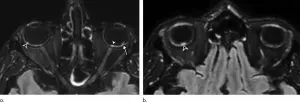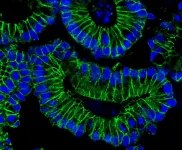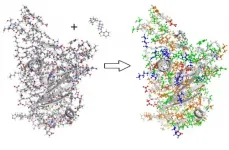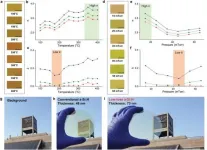(Press-News.org) OAK BROOK, Ill. - Researchers using MRI have found significant abnormalities in the eyes of some people with severe COVID-19, according to a study published in the journal Radiology. The study results support the need for eye screening in these patients to provide appropriate treatment and management of potentially severe ophthalmological manifestations of COVID-19.
The COVID-19 pandemic has affected more than 100 million people since it began early in 2020. While the virus primarily attacks the lungs, it has been linked with eye abnormalities like conjunctivitis, also known as pink eye, and retinopathy, a disease of the retina that can result in a loss of vision. Eye abnormalities visible on MRI exams have been reported but there is limited research on the nature and frequency of these abnormalities.
To find out more, the French Society of Neuroradiology (SFNR) initiated a study of 129 patients with severe COVID-19 who underwent brain MRI.
Of the 129 patients, nine (7%) had abnormal MRI findings of the globe, or eyeball. The MRI scans showed one or more nodules in the back part, or posterior pole, of the eyeball. Eight of the nine patients had spent time in the intensive care unit (ICU) for COVID-19.
"We showed that a few patients with severe COVID-19 from the French COVID-19 cohort had one or several nodules of the posterior pole of the globe," said study lead author Augustin Lecler, M.D., Ph.D., associate professor at the University of Paris and neuroradiologist from the Department of Neuroradiology at the Foundation Adolphe de Rothschild Hospital in Paris. "This is the first time these findings have been described using MRI."
All nine patients had nodules in the macular region, the area in the back of the eye responsible for our central vision. Eight had nodules in both eyes.
The results suggest that screening should be considered in all patients with severe COVID-19 to detect these nodules. In clinical practice, this screening could include dedicated exploration of the eyes with high-resolution MRI, the researchers said. Additional recommended exams include fundoscopy, which uses a magnifying lens and a light to check the back of the inside of the eye, and optical coherence tomography, a noninvasive test that provides a 3D picture of the structure of the eye.
Dr. Lecler noted that severe eye problems might largely go unnoticed in the clinic, as COVID-19 patients hospitalized in the ICU are often being treated for much more severe, life-threatening conditions.
"Our study advocates for screening of all patients hospitalized in the ICU for severe COVID-19," Dr. Lecler said. "We believe those patients should receive specific eye-protective treatments."
The mechanism behind nodule formation remains unknown, the researchers said, although it could be related to inflammation triggered by the virus. Inadequate drainage of the veins of the eyes, a problem found in patients who spend time in the ICU in the prone position or intubated, may also be a factor. Seven of the nine patients with eye abnormalities in the study had been placed in a prone position in the ICU for an extended time.
The researchers are performing follow-up clinical and MRI examinations in the survivors to monitor the nodules and see if they carry any clinical consequences such as vision loss or visual field impairment.
They are also performing MRI examinations in new patients with severe COVID-19 from the second and third waves of the pandemic, using more comprehensive ophthalmological tests to correlate with the MRI results.
The effects on patients with moderate COVID-19 are currently under investigation.
"We have launched a prospective study with dedicated high-resolution MR images for exploring the eye and orbit in patients with light to moderate COVID," Dr. Lecler said. "Therefore, we will be able to know whether our findings were specific to severe COVID patients or not."
The findings support previous research that showed COVID-19 exacts a greater toll in people with existing health problems. Of the nine patients with eye nodules, two had diabetes, six were obese and two had hypertension.
INFORMATION:
"Ocular MRI Findings in Patients with Severe COVID-19: A Retrospective Multicenter Observational Study." Collaborating with Dr. Lecler were François Cotton, M.D., Ph.D., François Lersy, M.D., Stéphane Kremer, M.D., Ph.D., and Françoise Héran, M.D., on behalf of the SFNR's COVID study group.
Radiology is edited by David A. Bluemke, M.D., Ph.D., University of Wisconsin School of Medicine and Public Health, Madison, Wisconsin, and owned and published by the Radiological Society of North America, Inc.
RSNA is an association of radiologists, radiation oncologists, medical physicists and related scientists promoting excellence in patient care and health care delivery through education, research and technologic innovation. The Society is based in Oak Brook, Illinois. (RSNA.org)
For patient-friendly information on MRI, visit RadiologyInfo.org.
Launched in 1988, the Global Polio Eradication Initiative (GPEI) stands out as one of the largest, internationally coordinated global public health major projects conducted to date, with cumulative spending of over $16.5 billion for 1988-2018, according to the World Health Organization (WHO). More than 30 years later, stubborn outbreaks of wild poliovirus still occur in Afghanistan and Pakistan, where cases have been increasing since 2018. The global eradication of polio continues to be an elusive goal.
A special issue of the journal Risk Analysis, titled "Global Poliovirus Risk Management and Modeling," looks at the current status of polio eradication ...
Earth is home to millions of known species of plants and animals, but by no means are they distributed evenly. For instance, rainforests cover less than 2 percent of Earth's total surface, yet they are home to 50 percent of Earth's species. Oceans account for 71 percent of Earth's total surface but contain only 15 percent of Earth's species. What drives this uneven distribution of species on Earth is a major question for scientists.
In a paper published February 16 in the Journal of Biogeography an international team of researchers led by Jacob S. Suissa, Ph.D. Candidate in the Department of Organismic and Evolutionary Biology, ...
Memorial Sloan Kettering Cancer Center (MSK) physicians and scientists presented new research at the 2021 American Society of Clinical Oncology Genitourinary Cancers Symposium held virtually February 11-13. Notably, MSK medical oncologist Robert Motzer, MD, presented encouraging data from a phase III randomized study that assessed two new treatment combinations as first-line treatments that may prolong survival in people with advanced kidney cancer. Dr. Motzer's findings were also published on February 13 in the New England Journal of Medicine.
In this large, international trial involving 200 sites across 20 countries, Dr. Motzer and a team of investigators ...
Using advanced RNA sequencing, scientists have identified two unique subtypes of a prominent mutation present in many patients with Acute Myeloid Leukemia (AML) - called NPM1 - that could help predict survival and improve treatment response for patients whose leukemic cells bear the mutation.
In research published Feb. 16, in Nature Communications, a team led by Princess Margaret Cancer Centre Senior Scientists, Drs. Benjamin Haibe-Kains, Aaron Schimmer and Mark Minden, have discovered that within the NPM1 mutation of AML there exists two unique subtypes, one of which can be effectively treated with drugs already in use.
It is the first study to classify within the common NPM1 mutant form of AML two subtypes, one being "primitive" and the other ...
Most people infected with SARS-CoV-2 are able to recover from the disease at home - even if they might experience very stressful disease progressions. Some have no symptoms at all. But about ten percent of those affected become so severely ill that they have to be treated in a hospital. The assumption that a weak immune system is behind a severe progression is short-sighted. Especially with critical progressions, the immune system works under intense pressure, but does not manage to control the virus.
A Berlin research group has now observed how SARS-CoV-2 uses an immune system defense mechanism to increasingly hijack ...
Computing - Modeling COVID dynamics
To better understand the spread of SARS-CoV-2, the virus that causes COVID-19, Oak Ridge National Laboratory researchers have harnessed the power of supercomputers to accurately model the spike protein that binds the novel coronavirus to a human cell receptor.
These simulations also shed light on the ligand molecules that can inhibit such binding, pointing the way to potential drug therapies.
An ultrafast quantum chemical modeling method provides information about the critical electronic interactions between protein and ligand chemicals, going beyond the classical interaction models that are normally employed in computational drug discovery.
The findings will enable accurate predictions of the performance of currently available inhibitors ...
The University of Kent has led a study highlighting the urgent need for the UK's Government and renewable energy industries to give vital attention to decommissioning offshore wind turbines approaching their end of live expectancy by 2025. The research reveals that the UK must decommission approximately 300 and 1600 early-model offshore wind turbines by 2025 and 2030, respectively.
Urgent focus is needed now to proactively use the remaining years until turbines installed in the 1990s and early 2000s are no longer safely functional in 2025, to prevent safety lapses, potentially huge costs and the irretrievable loss of the skillset required for safe decommission.
The research shows that these original turbines have an approximate lifetime of 20 to 25 years, but this expectation ...
Atropisomers are a class of stereoisomers (chemical compounds that differ in spatial arrangement of atoms) arising from restricted rotation around a single bond and have various applications in chemistry. To date, most research on atropisomers has focused on "biaryl atropisomers" (due to the rotational restriction around a carbon-carbon bond), but it is also possible for atropisomers to arise from rotational restrictions around a nitrogen-carbon (N-C) bond. These N-C axially chiral compounds are found in various natural products and bioactive compounds and thus have promising applications in medicine ...
A POSTECH research team has developed a transparent amorphous silicon that transmits visible light - which permits us to distinguish the colors of objects - enabling the development of paper-thin lenses usable in head-mounted displays (HMD) that show virtual and augmented reality images in real time.
A research team - led by Professor Junsuk Rho of POSTECH's mechanical engineering and chemical engineering departments, and Ph.D. candidate Younghwan Yang and Dr. Gwanho Yoon of the Department of Mechanical Engineering - has developed visibly transparent amorphous silicon by improving the plasma enhanced chemical vapor deposition (PECVD) method, a practice widely used by Korean display manufacturers. ...
Tsukuba, Japan - Sleep is very important for athletes, and sleep loss can affect physical performance and cognitive ability. But now, researchers from the University of Tsukuba have identified the prevalence of sleep disorders in visually impaired athletes, as well as specific risk factors associated with lower sleep quality.
In a study published last November in Sleep Medicine, researchers from the University of Tsukuba conducted a survey of 99 visually impaired athletes in Japan and analyzed data from 81 respondents. They found that approximately one-third of the respondents had sleep disorders. Further, higher levels of stress regarding interpersonal relationships ...






